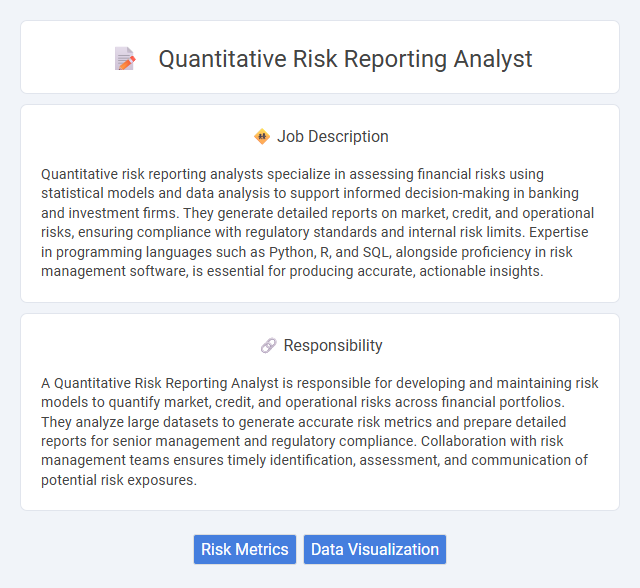
Quantitative risk reporting analysts specialize in assessing financial risks using statistical models and data analysis to support informed decision-making in banking and investment firms. They generate detailed reports on market, credit, and operational risks, ensuring compliance with regulatory standards and internal risk limits. Expertise in programming languages such as Python, R, and SQL, alongside proficiency in risk management software, is essential for producing accurate, actionable insights.
Individuals with strong analytical skills and a keen attention to detail are likely suitable for a Quantitative Risk Reporting Analyst role, as the job requires interpreting complex data and generating accurate risk assessments. Those who thrive in structured environments and can manage high-pressure situations may find this position fitting, given the critical nature of timely and precise reporting. Candidates with a background in finance, statistics, or data analysis may have a higher probability of success due to the technical demands and quantitative focus of the job.
Qualification
A Quantitative Risk Reporting Analyst requires strong expertise in statistical analysis, risk modeling, and financial data interpretation, typically supported by a degree in finance, mathematics, statistics, or a related quantitative field. Proficiency in programming languages such as SQL, Python, or R and experience with risk management software and reporting tools are essential for generating accurate risk assessments. Strong analytical skills, attention to detail, and the ability to communicate complex risk metrics to stakeholders complete the ideal qualifications for this role.
Responsibility
A Quantitative Risk Reporting Analyst is responsible for developing and maintaining risk models to quantify market, credit, and operational risks across financial portfolios. They analyze large datasets to generate accurate risk metrics and prepare detailed reports for senior management and regulatory compliance. Collaboration with risk management teams ensures timely identification, assessment, and communication of potential risk exposures.
Benefit
Quantitative risk reporting analysts likely improve decision-making accuracy by providing detailed data analysis and risk assessments. Their work probably aids organizations in identifying potential financial threats early, enhancing risk mitigation strategies. This role may also increase transparency and regulatory compliance through precise and timely reporting.
Challenge
Quantitative risk reporting analyst roles likely present the challenge of accurately interpreting complex financial data to identify potential risks. The responsibility to develop precise risk models that can predict future uncertainties may require continuous learning and adaptation to new methodologies. Navigating regulatory changes while ensuring compliance could also pose significant hurdles in maintaining effective risk management frameworks.
Career Advancement
Quantitative risk reporting analysts leverage statistical models and data analysis to assess financial risks, driving informed decision-making in banking and investment firms. Mastery of programming languages such as Python and R, coupled with expertise in regulatory frameworks like Basel III, significantly enhances career progression opportunities. Advanced roles often lead to positions as risk management directors or chief risk officers, where strategic oversight and regulatory compliance are critical.
Key Terms
Risk Metrics
A Quantitative Risk Reporting Analyst specializes in analyzing and interpreting risk metrics to provide comprehensive insights into financial risk exposures. Expertise in risk metrics such as Value at Risk (VaR), Conditional Value at Risk (CVaR), and volatility measures is critical for monitoring market, credit, and operational risks. Proficiency in advanced statistical techniques and financial modeling tools enables accurate risk quantification and effective decision-making support.
Data Visualization
A Quantitative Risk Reporting Analyst specializes in transforming complex risk metrics into clear, actionable insights through advanced data visualization techniques. Proficiency in tools like Tableau, Power BI, and Python libraries such as Matplotlib or Seaborn enhances the ability to communicate risk exposures, stress test results, and scenario analyses to stakeholders. Effective visualization streamlines decision-making by highlighting trends, anomalies, and key risk indicators within financial and operational datasets.
 kuljobs.com
kuljobs.com